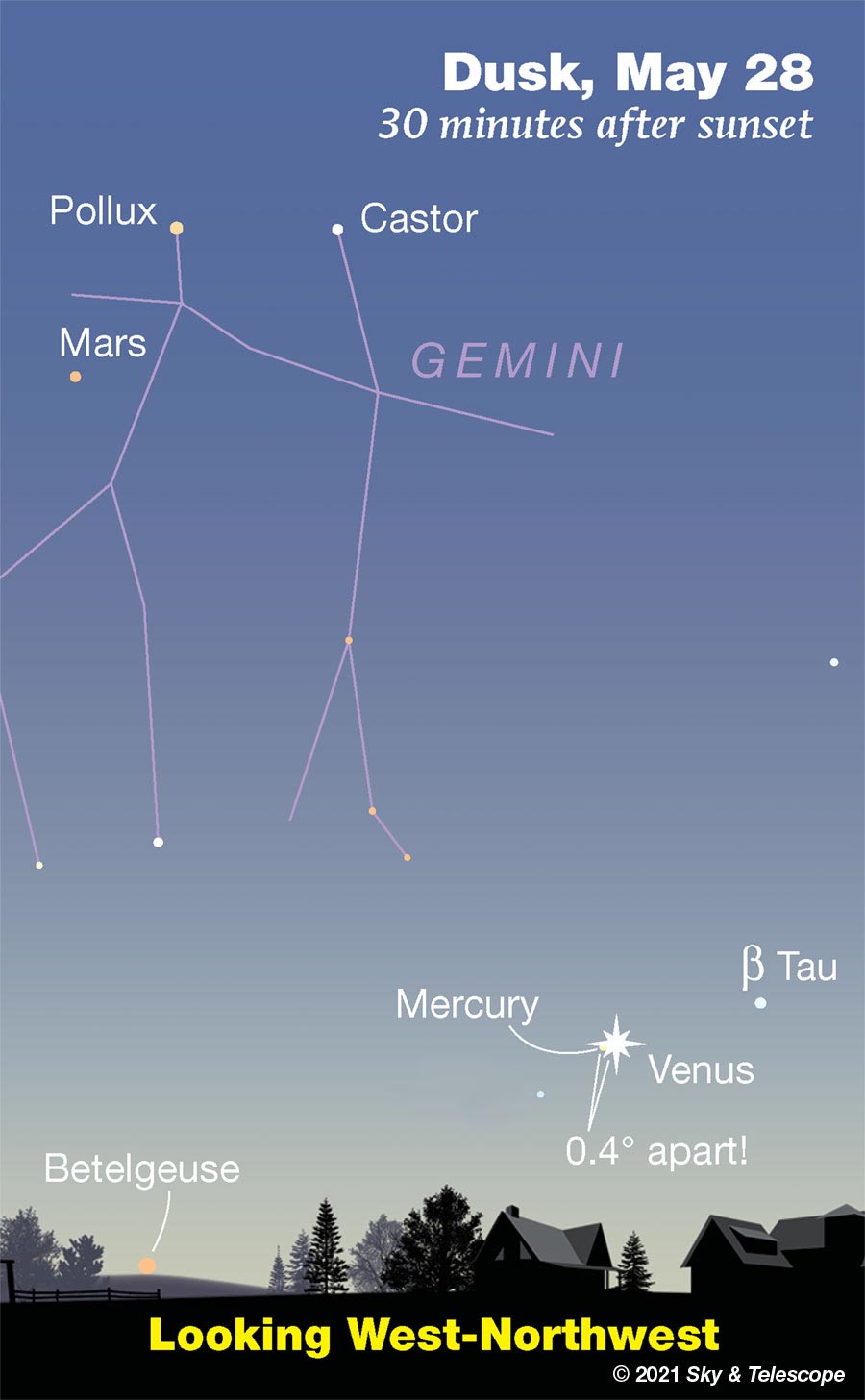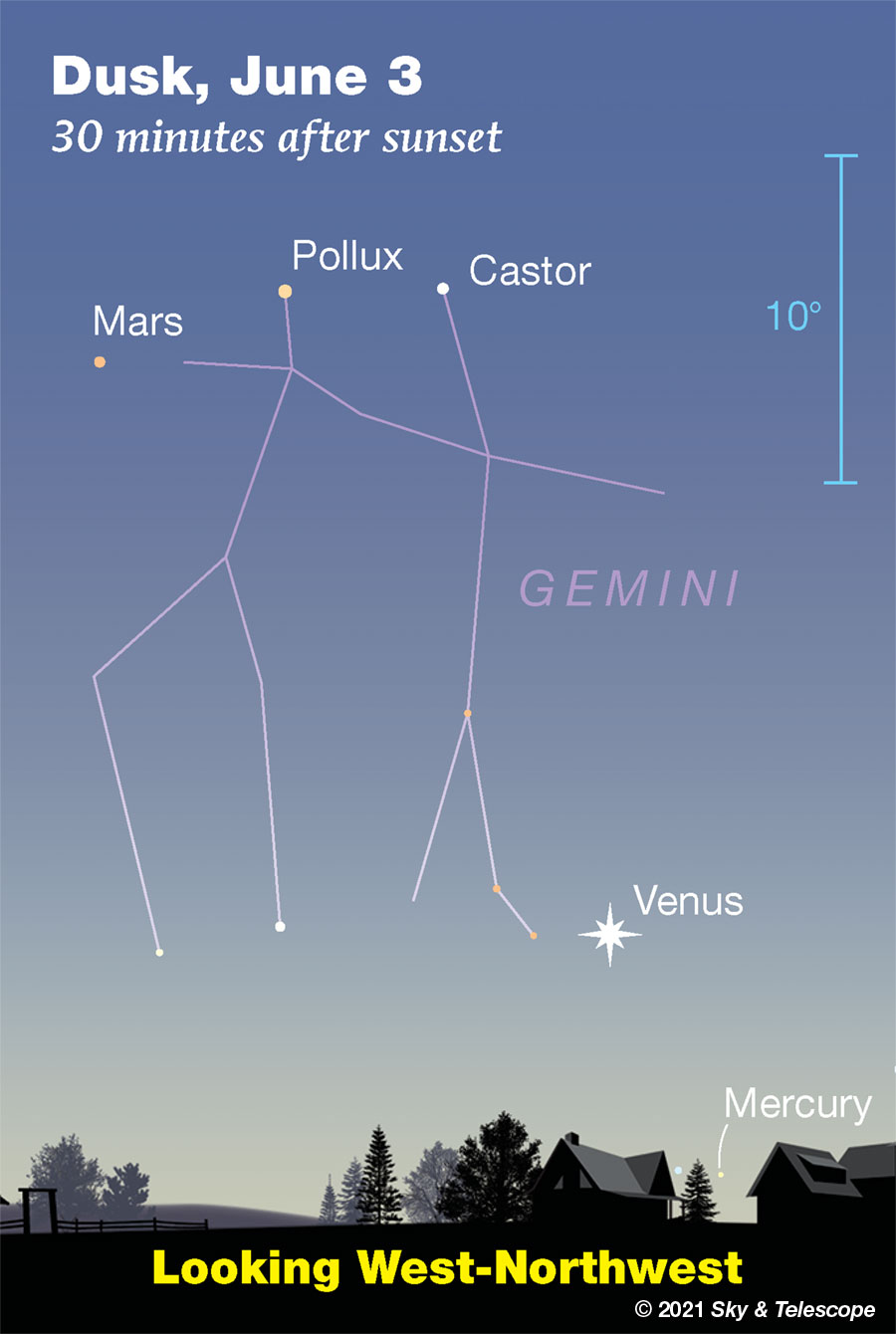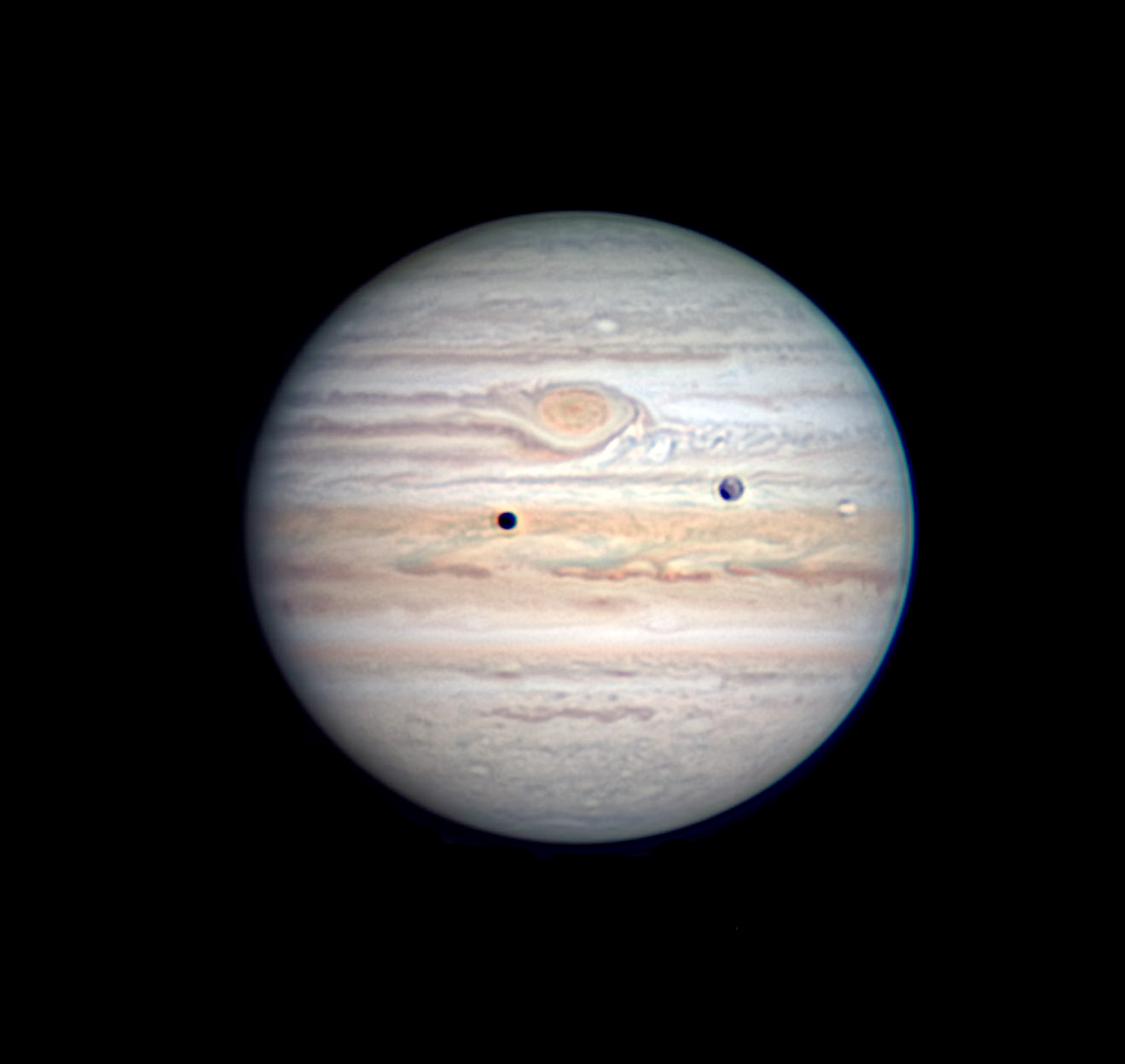Nova Cassiopeiae, continued: It's been 10 weeks since Nova Cas 2021 (V1405 Cas) erupted to shine at about magnitude 7.7. Surprisingly, it has stayed about that bright ever since — except for swelling to 5.3, faint naked-eye visibility, for a week in early-mid May. As of June 1st it was about 7.3.
The nova is low-ish in the north-northeast after dark, depending on your latitude. It climbs higher through the night and is very high before dawn. Charts and comparison stars.
FRIDAY, MAY 28
■ Mercury and Venus have their conjunction this evening, just 0.4° apart. Look quite low in the west-northwest about 40 minutes after sundown. What you will see there is Venus, bright at magnitude –3.8. Mercury has dwindled to a mere magnitude +2.3, only 1/275 as bright! So bring binoculars or a telescope to pick Mercury out of the skyglow. For North Americans, Mercury will be to Venus's left or lower left as shown below. Good luck!

SATURDAY, MAY 29
■ Bright Capella sets low in the northwest fairly soon after dark now, depending on your latitude. That leaves Vega and Arcturus as the brightest stars in the evening sky. Vega shines in the east-northeast. Arcturus is very high toward the south.
A third of the way from Arcturus down to Vega, look for the dim semicircle of Corona Borealis, with 2nd-magnitude Alphecca as its one moderately bright star.
Two thirds of the way from Arcturus to Vega is the dim Keystone of Hercules, now lying almost level.
Use binoculars or a telescope to examine the Keystone's top edge. A third of the way from its left end to the right is 6th-magnitude M13, one of Hercules's two great globular star clusters. In binoculars it's a tiny glowing cottonball. A 4- or 6-inch scope begins to resolve some of its speckliness. Located 22,000 light-years away far above the plane of the Milky Way, it consists of several hundred thousand stars in a swarm about 140 light-years wide.
SUNDAY, MAY 30
■ Late spring is when Leo starts walking downward toward the west, on his way to departing into the sunset in early summer. Right after dark, spot the brightest star toward the west-southwest. That's Regulus, his forefoot.
■ The early dawns and bright early mornings of the warm-weather season are a gorgeous time to enjoy the outdoors uncrowded. Habitual slugabeds don't know what they're missing. If you're one of those adventurous few — or if you have a crack-of-dawn commute — in early dawn Monday and Tuesday you will find the waning crescent Moon hanging below Saturn on Monday and below Jupiter on Tuesday.
MONDAY, MAY 31
■ Constellations seem to twist around fast when they pass your zenith — if you're comparing them to the direction "down." Just a week and a half ago, the Big Dipper floated horizontally in late twilight an hour after sunset (as seen from around 40° N latitude). Now it's angled diagonally at that time. In just another week and a half it will be hanging straight down by its handle!
■ Zero-magnitude Vega dominates the east-northeast as evening advances. Look for its constellation Lyra hanging down from it: a small, almost-equilateral triangle with Vega as its top corner, and from the triangle's bottom corner, a larger parallelogram hanging to the lower right.
The bottom two stars of the parallelogram, Beta and Gamma Lyrae, are the two brightest stars of the pattern after Vega. The one farthest from Vega is Gamma. Most of the time the pair are almost indistinguishable in brightness: Gamma is visual magnitude 3.25, and Beta is 3.4. But Beta is a famous eclipsing variable, one of the first discovered. Look up at the pair often enough, and sooner or later you will catch Beta very obviously dimmer than Gamma, near its minimum brightness of mag 4.3. More often you're likely to catch it somewhere in between, when the brightness difference between them is clearly apparent but not so striking.
TUESDAY, JUNE 1
■ When the Big Dipper is high in the north in late spring and summer, what's down low in the north?
Think half a year ago. In late fall and winter Cassiopeia stood where the Dipper does now. That means that Cas currently lurks low.
As twilight fades out, look for it down near the north horizon: a wide, upright W. The farther north you live the higher it'll appear, but even as far south as San Diego and Atlanta it's fully above the horizon.
■ Last-quarter Moon tonight (exactly so at 3:42 a.m. Wednesday morning EDT). In most of North America, the Moon rises roughly 2 a.m. daylight-saving time. Jupiter and Saturn shine to its upper right. By early dawn, they're higher in the southeast.
And before dawn gets too bright, can you spot Fomalhaut, the Autumn Star, low down almost two fists to the Moon's lower right?
WEDNESDAY, JUNE 2
■ A gigantic asterism you may not know about is the Great Diamond, some 50° tall and extending over five constellations. It now leans in the south to southwest after dusk.
Start with Spica, its bottom. High above Spica is bright Arcturus. Almost as far upper right from Arcturus is fainter Cor Caroli, 3rd magnitude. The same distance down from there is Denebola, the 2nd-magnitude tailtip of Leo. And then back to Spica. Robert H. Baker may have been the first to name the Great Diamond, in his 1954 book When the Stars Come Out.
The bottom three of these stars, the brightest, form a nearly perfect equilateral triangle. We can call this the "Spring Triangle" to parallel to those of summer and winter. The first to name it such was probably the late Sky & Telescope columnist George Lovi, writing in the March 1974 issue. But the name didn't catch on at the time, so let's try again. (Here's to you, George!)
■ Can you see the big Coma Berenices star cluster? Does your light pollution really hide it, or do you just not know exactly where to look? It's halfway from Cor Caroli to Denebola.
The cluster's brightest members form an inverted Y. The entire cluster is about 4° wide — a big, dim glow in a fairly dark sky, the size of a ping-pong ball at arm's length. It nearly fills a binocular view.
THURSDAY, JUNE 3
■ Mercury has faded and sunk out of twilight sight, but Venus continues to creep just a tiny bit higher, toward the feet of Gemini as shown below. As night darkens, can you trace out the whole stick figure Twins before Venus sets? Binoculars can help you pick out the fainter stars through twilight, but remember how small a field of view binoculars show you (typically 5° to 8° wide) compared to the much larger constellation. And don't forget Mars demanding attention! See below.

FRIDAY, JUNE 4
■ For much of the spring at mid-northern latitudes, the Milky Way lies right down out of sight all around the horizon. But watch the east now. The rich Cepheus-Cygnus-Aquila stretch of the Milky Way rears up horizontally across the east late these nights, earlier and higher every week. A hint for the light-polluted: It runs horizontally under Vega, right through the bottom of the Summer Triangle.
SATURDAY, JUNE 5
■ Have you ever seen Alpha Centauri? At declination –61° , this magnitude-zero shiner is permanently out of sight if you're north of latitude 29°. But if you're at the latitude of San Antonio, Orlando, or points south, Alpha Cen skims just above your southern true horizon for a little while late these evenings.
When does this happen? When should you look? Just about when Alpha Librae, the lower-right of Libra's two brightest stars, is due south over your landscape. At that time, drop your gaze down from there!
■ Make your plans for the eclipse of the Sun coming up on the morning of June 10th! The eclipse will be annular for the few of you in north-central Ontario and points north across the arctic. But a partial eclipse will occur northeast of a line from the Carolinas through North Dakota. In the US Northeast and eastern Canada, the rising crescent Sun will be spectacular! For full details, maps, and local timetables, see Joe Rao's article in the June Sky & Telescope, page 34.
Europe and most of Russia will see the partially eclipsed Sun high in the middle of the day.
This Week's Planet Roundup
Mercury and Venus are in conjunction on Friday evening May 28th, just 0.4° apart low in the afterglow of sunset. See that date above. Venus should be easy to spot if the sky there is clear. But Mercury will be only 1/275 as bright, so bring binoculars or a telescope.
In the following days Mercury fades even further and drops down below Venus. Bye-bye!
Mars (magnitude 1.7, in Gemini) glows in the west right after dark. It's that modest little firespark lower left of Pollux and Castor. Far-off Mars is no brighter than even Castor, the fainter of the Pollux-and-Castor "twins." In a telescope Mars is just tiny blob 4.2 arcseconds wide.
Jupiter and Saturn (in dim Aquarius and Capricornus, respectively) shine in the southeast before the first light of dawn. Jupiter dominates at magnitude –2.4. Saturn, 18° to Jupiter's right, is a more modest +0.6.

A dark line now nearly encircles the Red Spot Hollow. It looks like a continuation of the two narrow dark bands at left; the whole thing has taken on the "snake head" pattern we've seen before. The Red Spot is the snake's enormous eye. His nose points right (toward celestial east; following).
Don't get too excited; Jupiter shows nowhere near this level of detail visually, especially from latitudes higher than Go's near-equatorial 10° N. For those of us less ideally placed, Jupiter remains fairly low in poor telescopic seeing even as dawn begins.
Uranus remains out of sight in the glow of dawn.
Neptune, in Aquarius 22° east of Jupiter, lurks low in the east-southeast before dawn begins.
All descriptions that relate to your horizon — including the words up, down, right, and left — are written for the world's mid-northern latitudes. Descriptions that also depend on longitude (mainly Moon positions) are for North America.
Eastern Daylight Time, EDT, is Universal Time minus 4 hours. Universal Time is also known as UT, UTC, GMT, or Z time. To become more expert about time systems than 99% of the people you'll ever meet, see our compact article Time and the Amateur Astronomer.
Want to become a better astronomer? Learn your way around the constellations. They're the key to locating everything fainter and deeper to hunt with binoculars or a telescope.
This is an outdoor nature hobby. For an easy-to-use constellation guide covering the whole evening sky, use the big monthly map in the center of each issue of Sky & Telescope, the essential magazine of astronomy.
Once you get a telescope, to put it to good use you'll need a detailed, large-scale sky atlas (set of charts). The basic standard is the Pocket Sky Atlas (in either the original or Jumbo Edition), which shows stars to magnitude 7.6.

Next up is the larger and deeper Sky Atlas 2000.0, plotting stars to magnitude 8.5; nearly three times as many. The next up, once you know your way around, are the even larger Interstellarum atlas (stars to magnitude 9.5) or Uranometria 2000.0 (stars to magnitude 9.75). And be sure to read how to use sky charts with a telescope.
You'll also want a good deep-sky guidebook, such as Sky Atlas 2000.0 Companion by Strong and Sinnott, or the bigger (and illustrated) Night Sky Observer's Guide by Kepple and Sanner.
Can a computerized telescope replace charts? Not for beginners, I don't think, and not on mounts and tripods that are less than top-quality mechanically, meaning heavy and expensive. And as Terence Dickinson and Alan Dyer say in their Backyard Astronomer's Guide, "A full appreciation of the universe cannot come without developing the skills to find things in the sky and understanding how the sky works. This knowledge comes only by spending time under the stars with star maps in hand."
![]() Audio sky tour. Out under the evening sky with your
Audio sky tour. Out under the evening sky with your
earbuds in place, listen to Kelly Beatty's monthly
podcast tour of the heavens above. It's free.
"The dangers of not thinking clearly are much greater now than ever before. It's not that there's something new in our way of thinking, it's that credulous and confused thinking can be much more lethal in ways it was never before."
— Carl Sagan, 1996
"Facts are stubborn things."
— John Adams, 1770
 6
6









Comments
mary beth
May 30, 2021 at 12:45 pm
Happy Decoration Day/Memorial Day weekend to all. Hope everyone is enjoying clear skies and the freedom that our brave soldiers gave their lives for!
Wow I finally got to see Venus after many cloudy evenings and it was quite a sight! Vega has been enjoyable here in Houston. I can’t believe how high Arcturus is even at last light, crossing the zenith at 11pm.
As the stars that shall be bright when we are dust,
Moving in marches upon the heavenly plain;
As the stars that are starry in the time of our darkness,
To the end, to the end, they remain.–Laurence Binyon (1869–1943)
You must be logged in to post a comment.
Rod
May 30, 2021 at 6:56 pm
Same to you mary beth. Memorial Day was established in May 1868 in memory of the slain and fallen during the civil war and the 13th amendment was ratified that year too abolishing slavery. In Maryland, I have enjoyed clouds and rain but tomorrow morning looks better to view Saturn, Jupiter, and the waning gibbous Moon. If good weather, I plan to setup my telescope (90-mm refractor) and enjoy some views of the three. Saturn began retrograding in Capricornus on 23-May near the star Theta Capricorni. So if you follow over the days and weeks, Saturn will move away from this star retrograding.
You must be logged in to post a comment.
Rod
May 30, 2021 at 7:03 pm
my bad. 1865 for 13th amendment. 1868 Memorial Day. Major changes to US Constitution after civil war, 13th, 14th, and 15th amendments. I hope to be out tomorrow morning near 0400 EDT.
You must be logged in to post a comment.
mary beth
May 31, 2021 at 12:59 am
When I was a little girl I did not appreciate Civil War history but I certainly do now.
Look forward to a good report from you tomorrow on your Memorial Day planet watch, and that the weather cooperates. Let me know how well you can see the rings of Saturn. Maybe you can take a nap afterwards, especially if you are cooking out for a lot of friends later in the day!
Hope everyone has a safe and enjoyable day!
You must be logged in to post a comment.
Rod
May 31, 2021 at 9:07 am
mary beth. I slept in this morning 🙂 0330 time setup in the pasture slipped by me 🙂
I did enjoy a good cook out with family yesterday.
You must be logged in to post a comment.
mary beth
May 31, 2021 at 12:57 pm
Good morning Rod! That is just about as good of a report as a star report because it’s nice to know you had such a wonderful day yesterday and a delicious meal and relaxed this morning! Thankfully, as we know, the stars and planets will be waiting for us again tonight! Y’all have a fun remainder of the Holiday! We did our cooking yesterday as well so today is relaxing and reflecting.
You must be logged in to post a comment.
You must be logged in to post a comment.